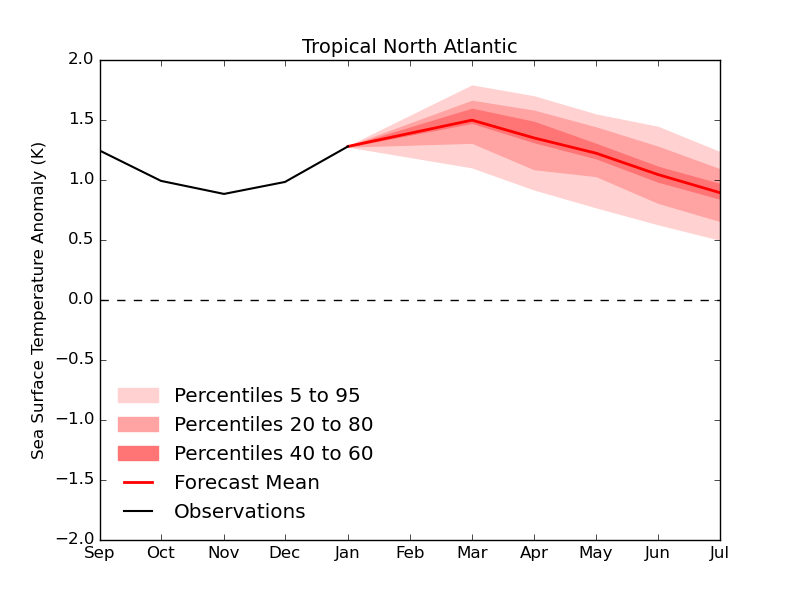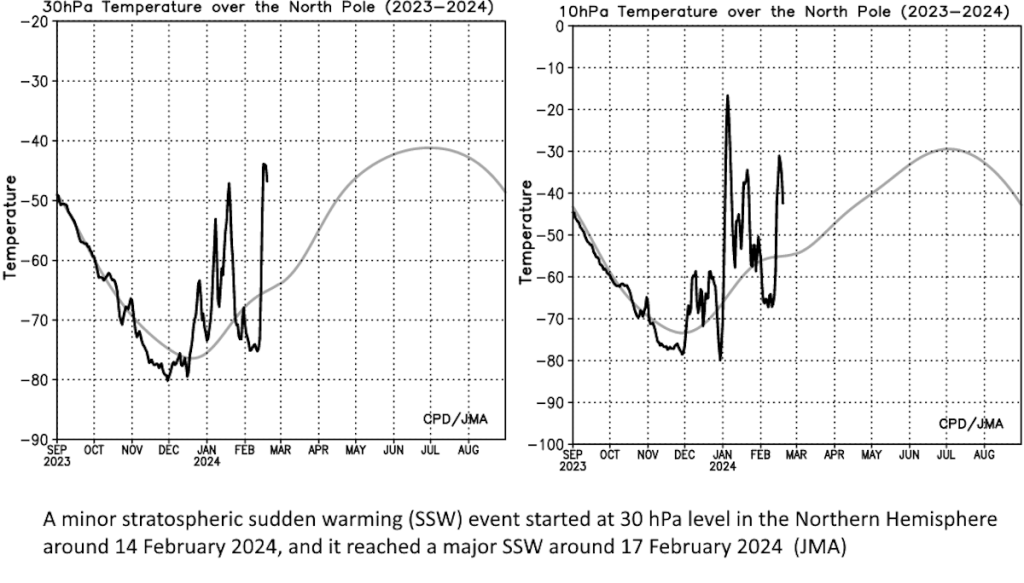Published 20 February 2024
GDPR statement: Please note that the author of this blog does not set cookies but the host “wordpress.com” sets multiple cookies which are outside of the authors control. You can view their cookie policy here.
A: Overview
1. Influences.
Changes in sea temperature

Sea temperature anomalies across the North Atlantic remain warmer than climatology for the middle of February. Areas around the UK, Europe, Mediterranean show 1 or 2 Celsius positive anomalies. Pacific ocean anomalies along the equator show an established El Nino state and the Atlantic looks to have similar anomalies to those in December.
The Tropical Atlantic sea temperature anomalies are warmer than average and are forecast to maintain positive anomalies into Summer 2024. (see Met Office graphic below).
Tropical Pacific Sea Surface Temperatures (Nino3.4) are in an El Nino state and forecast to become neutral during Spring. Indication are for the formation of a strong La Nina in the second half of this year.
The North Atlantic Oscillation index (500hPa index shown below) became negative in early January 2024 then turned positive except for a short dip in early February. The forecast trend is towards a neutral state by early March. A positive NAO reflects a more mobile westerly type but neutral conditions are inconclusive.

See https://www.metoffice.gov.uk/weather/learn-about/weather/atmosphere/north-atlantic-oscillation
2. Tropical storms etc: (Data from Wikipedia)
Southern Indian 2023-2024. Tropical cyclones 3, intense cyclones 2. Fatalities 25.
South Pacific Ocean 2023-2024. Tropical cyclones 4, severe cyclones 2. Fatalities 2.
Australia region 2023-2024. Tropical cyclones 4, severe cyclones 3. Fatalities 1. Damage 675million USD.
UK Named storms:
January 19th, Storm Isha centre moved across the fat N of Scotland but brought gale or severe gale winds to many areas, including SW England where Amber and Yellow warnings were in force. January 22nd storm Jocelyn followed quickly but this depression passed further to the north of Scotland with strong to gale winds for SW England.
Details of the storms can be found on the Met Office Storm web page: https://www.metoffice.gov.uk/weather/warnings-and-advice/uk-storm-centre/index
3. Recent Climatology
SW England: The mean temperatures has been two or three degrees about the February long term average and rainfall has also been well above average. This is illustrated by the temperature anomaly for the period 4th to 10th February and rainfall total for the same period as shown below.
Reservoir levels, according to SW Water, are above the long term average across SW England as of 11th February 2024.
UK October November December 2023, January 2024
Met Office provisional Temperature and Rainfall anomalies for 2023 November and December and January 2024 are shown below. You can see the effect of an increase in average temperatures in the 1991 to 2020 period (right hand mini pictures) when comparing the images for the different 30 year averaging period. Temperatures in most areas were above average for the three month period thanks to a much milder December when compared to the recent 30 year average. Rainfall was notably above average in the S and E of the UK whereas W Scotland had below average precipitation.

River flows and ground water levels in January 2024 can be found in the Hydrological Summary
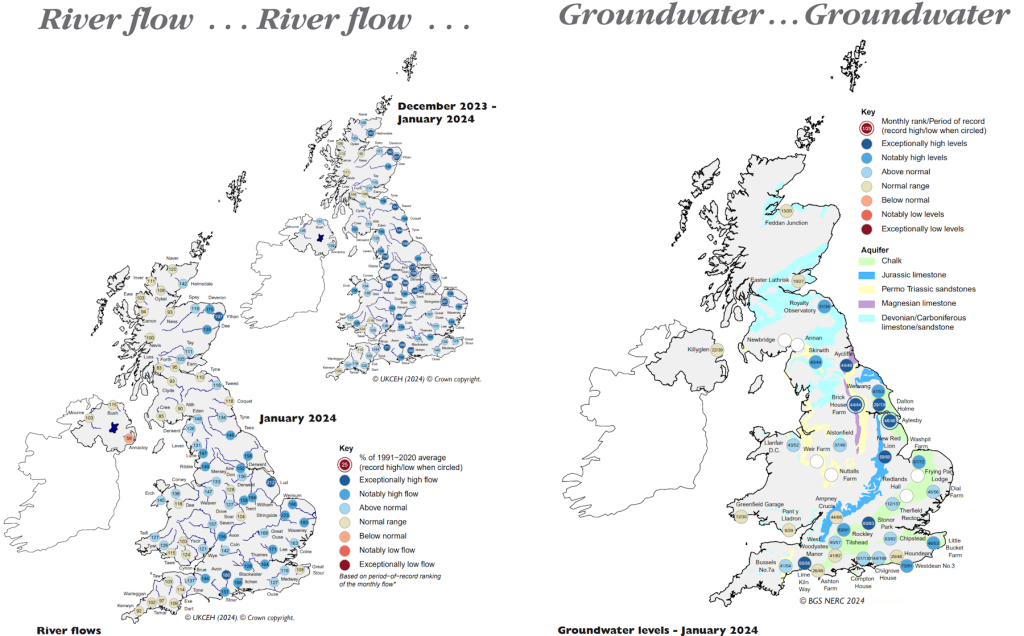
The Global Flood Awareness System – GloFAS – forecast from February 1st 2024 to end of May 2024. Although the map does not shown any enhanced flood risk across Southern England a look at individual rivers suggest higher than average flows are more likely than below average flow over the months ahead. Flash flooding, from for example thunderstorms, is not covered by this system.
Europe Climate:
Copernicus, European sourced temperature and rainfall anomalies for January 2024 and the 12 months to the end of January compared with the 30 year periods 1991-2020 (left) and 1981-2010 (right) shown below:

B: Forecast data:
1. Stratosphere:
According to the “Tokyo Climate Center”, a second (minor) stratospheric sudden warming (SSW) event started at 30 hPa level in the Northern Hemisphere around 14 February 2024.
The North Polar Stratospheric Vortex weakened or a period due to a significant warming and then redeveloped. The current warming has displaced the vortex and a series of ongoing warming events may lead to the early demise of the winter vortex as shown in the forecast sequence below.
The median date for “summer vortex” when winter stratospheric polar vortex breaks down and switches semi-permanently from westerly to easterly winds is April 12th. The latest final warming (FW) on record occurred 11 May 1981.
Current guidance indicates that a FINAL WARMING might occur around 7th March, which is about 4 weeks earlier than average. The earliest date on record occurred in 2016 on March 5th which was also a strong El Niño winter. The demise of the westerly stratospheric flow over the Atlantic/Europe could mean that a cold spell may develop in March due to reduced Atlantic mobility OR it could mean an early Spring is possible – something that has already started in SW England.
2. Upper troposphere:
CFSv2 200hPa contours (top row) and CFSv2 anomaly (middle row) and NMME anomaly (lower row) for 2024 March April May. Charts may suggest reduced Atlantic mobility.
3. Lower Troposphere:
A selection of model solutions for February March April 2024 using January data are shown below. The full set can be found at https://www.weather-info.co.uk/wxsvc/seaslatest.html
Top row temperature anomaly. Lower row precipitation anomaly
March to May 2024

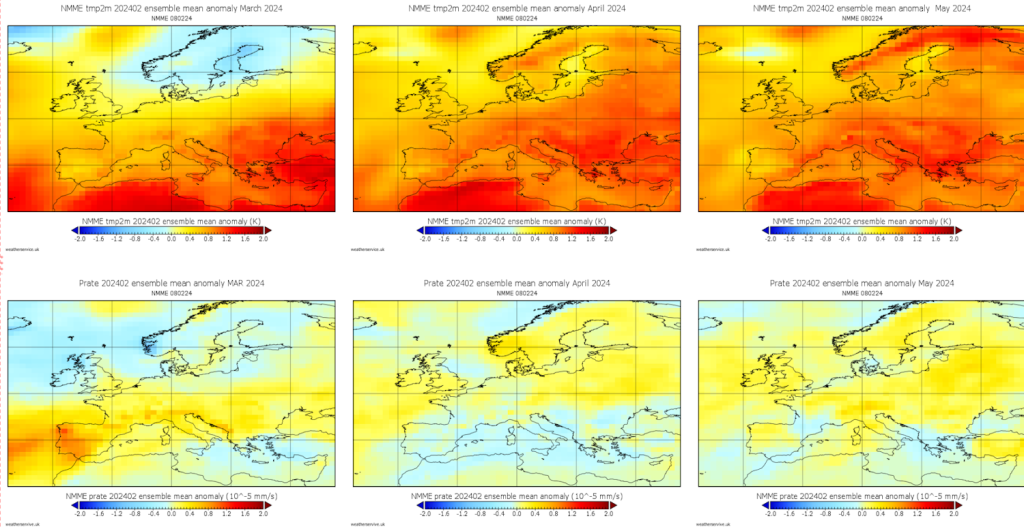

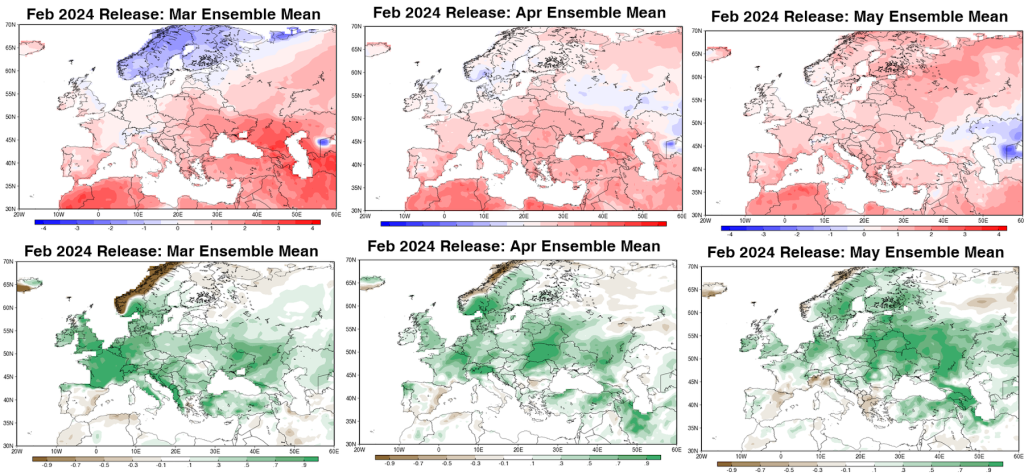
Data from WMO:
Three month average anomaly followed by March April May 2024. Top row temperature anomaly and lower row precipitation anomaly.
WMO super ensemble (below) is a mean of data supplied by National Meteorological organisations across the globe. Because of the amount of data the output is a low resolution.
Data shown is multi model anomaly probability charts except for Pune, India Met Department which shows deterministic mean anomaly.
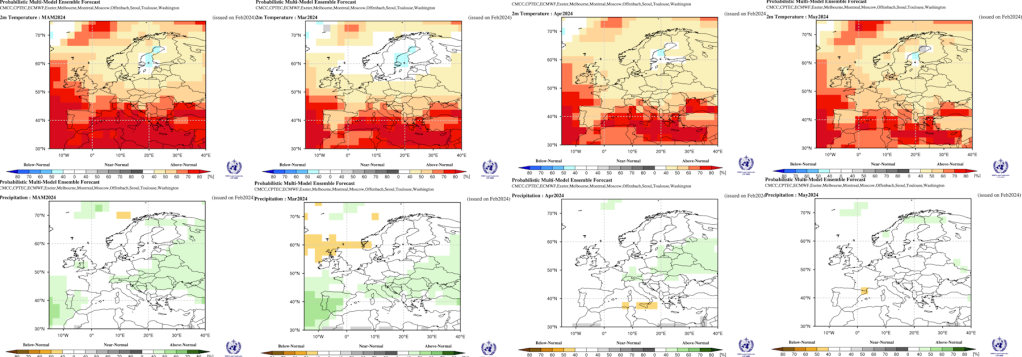
Individual members of the WMO super ensemble are shown below. (Beijing missing).
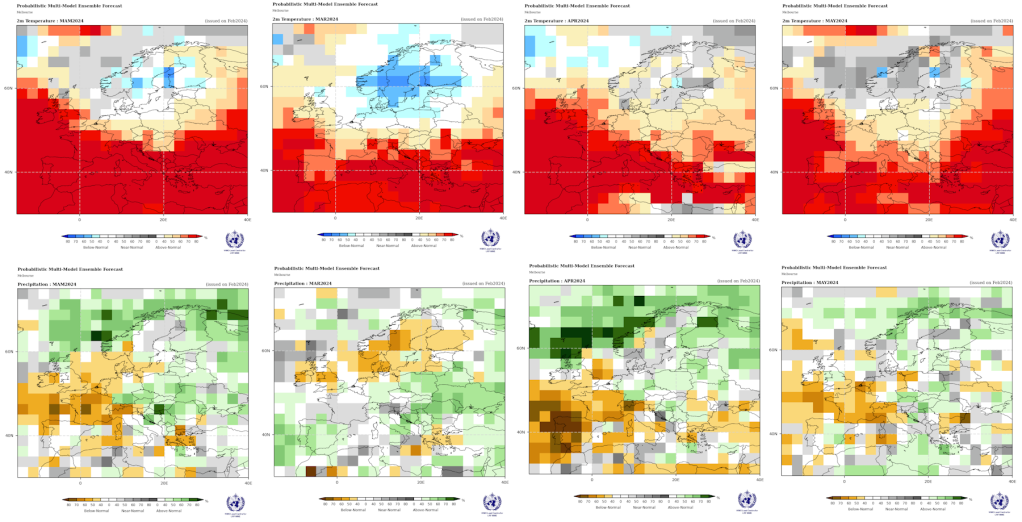



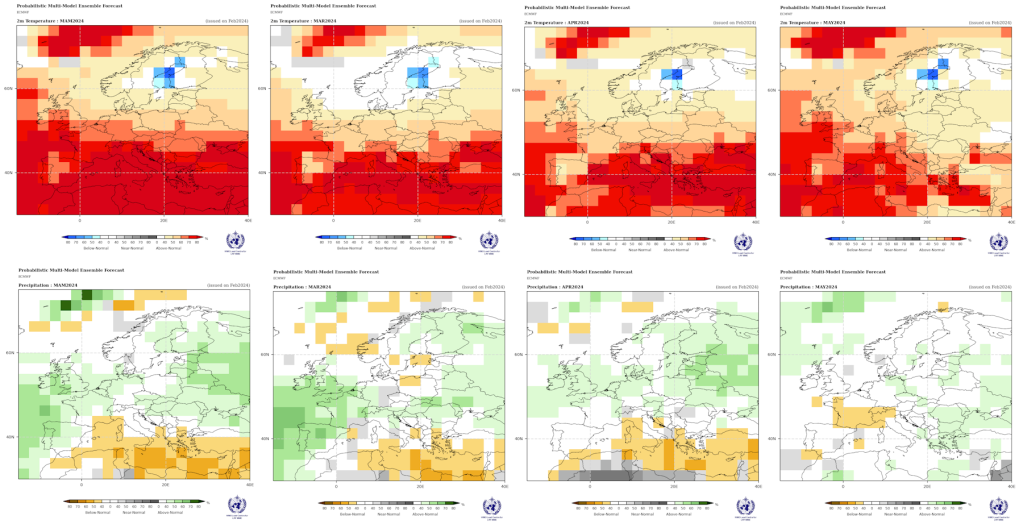

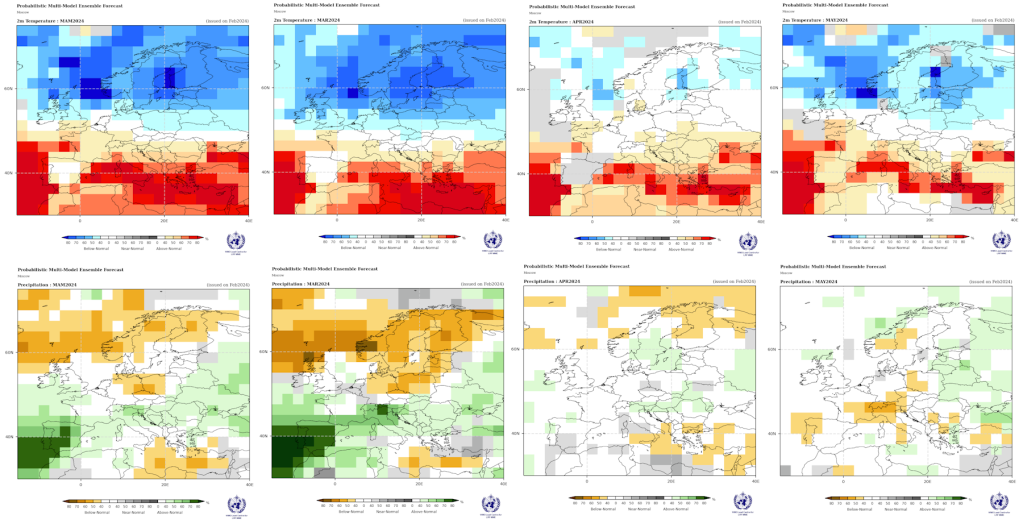



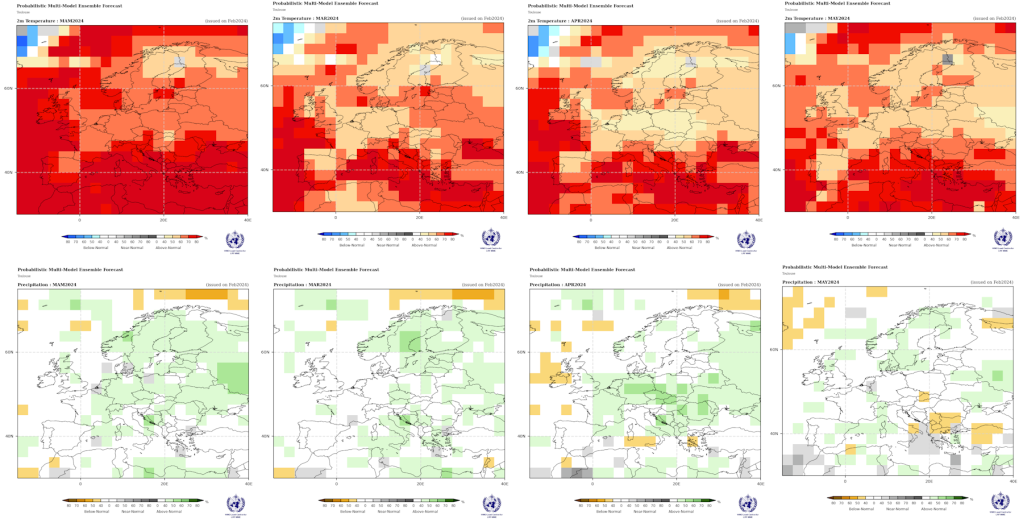


C: Comparing previous output for UK area:
NOTE: 30 year period 1981-2010 no longer available from UKMO web site now using newer 30 year period 1991 to 2020 which has higher temperature averages. 1961-1990 shown for comparison.
Review of details looked for in seasonal forecast for November 2023 to January 2024r, using October 2023 data.
Observed data
Temperature. Overall above average for the three month period mostly due to December. November and January near the 1991-2020 average but each month above the 1961-1990 average.
Rainfall. NW/W Scotland below average for the three month period elsewhere above averahelargely due to wet December.
Sunshine. Wales below average elsewhere mostly above average
Pressure. Below average despite January being slightly above average
Original Summary -171023.
Temperature for the three month period all models suggest the mean is likely to be above average although a few models suggest reduced anomalies and hint at near normal in the south of UK in December and / or January. Rainfall, main theme is for above normal rainfall, especially in western and southwesterly parts. The N or NW of the UK may have normal or below normal winter rainfall. Some indication of longer drier spells but detail inconsistent. Snowfall probably below normal in south but normal in the north. Dominant theme is for unsettled westlery types and below average pressure but does not preclude a colder anticyclonic period some time in December and or January.
Note 1: Large scale blocking with easterly types seem to only be forecastable about two weeks ahead.
Comment: 030324, overall indication of above average temperature anbd rainfall was good and hint a drier colder spell for December and or January turned out ok for January but not December which had the higher positive anomalies. Good signal for below averaghe rain in NW of UK but less good for W of UK alough SW and S England was above average except in January.
Scoring will attempt to state good, fair, poor or no signal for the 3 month period average not individual months.
Revised order
1. Russia (WMO): Temp Missing .
2. USA – CFS2 : Temp good . PPN fair .
3. UKMO Contingency: Temp fair . PPN good .
4. UKMO : Temp good . PPN good . PMSL good
5. USA – IRI : Temp good . PPN good .
6. KMA APCC : Temp missing
7. JMA : Temp good. PPN good . PMSL good
8. NMME : Temp good . PPN good.
9. WMO multi : Temp good . PPN good .
10. BCC : Temp good . PPN good .
11. NASA : Temp good . PPN poor .
12. CanSips : Temp good . PPN good.
13. Copernicus Temp good . PPN good . PMSL good
14. CMCC Temp good . PPN good . PMSL fair
15: DWD Temp good . PPN good . PMSL fair
16. ECMWF Temp good . PPN good . PMSL fair
17 JMA Temp good . PPN good . PMSL good
18 UKMO Temp good . PPN good . PMSL fair
19. MF Temp good . PPN fair . PMSL poor
20 NCEP Temp good. PPN good . PMSL fair
21 ECCC Temp: good . PPN good . PMSL good
WMO low res data: 3 month period. Temperature UKMO hinted at higher anomalies in December but overall models were a little warm. Rainfall CMCC CPTEC and BoM had the wetter anomalies in December and lower ones otherwise.
BoM Temp good. PPN good .
Can Temp good. PPN good .
DWD Temp good. PPN good .
KMA Temp good. PPN good .
MOSC Temp good. PPN good/fair .
WASH Temp good. PPN good .
CMA Temp good. PPN good .
ECMWF Temp good. PPN good .
UK Temp good. PPN good .
JMA Temp good. PPN good
MF Temp good. PPN good .
CMCC Temp good. PPN good .
CPTEC Temp good. PPN fair.
D: Text Forecast for SW England
Spring 2024 (March April May).
Temperature for the season likely to be above average although there is a chance that March, after a mild start, could turn colder and be nearer normal or even a little colder than average. This colder theme might also extend into early April but cold spells are unlikely to be prolonged.
Rainfall for SW England is likely to be above average for the the Spring period although this may be largely due to a wet May. March could well see near average rainfall totals and above average incidence of snow (and frost) for short period during the month, probably after mid March. Rainfall in April probably near average across with May wetter than average.
Spring climate: 1981-2010 average mean temperature 9 or 10°C but a few degrees cooler over the moors. Roughly Mar 7 or 8°C Apr 8 or 9°C May 11 or 12°C. Average 1981 to 2010 rain 200 to 300mm lowest values in E Devon and over parts of Somerset.
Summer 2024 (June July August) limited data.
Temperature expected to mean about 1 or 2 degrees Celsius above climatology. Rainfall totals likely to be near average, perhaps drier early and wetter later in the summer. Very localised thunderstorms can increase the rain totals so perhaps a below average number of rain days might be a better indication.
Summer climate: 1981 to 2010 average daily mean temperature 14 or 15°C in many areas to 16 or 17°C in main urban areas also locally east of the moors and more widely in Somerset. Maximum temperatures average 19 to over 21°C in similar areas. July often warmer than August. Average 1981 to 2010 rain 300mm over the moors, typically 200 to 250mm in many coastal and eastern areas. June often drier than July and July drier than August.
E: Caution.
Experimental Long Range Forecasts do not have a good success rate, especially with regards to precipitation. The models are good at predicting above average values but not for picking out a one off colder month. The data used for the above forecast summary can be seen at here.
The attempt at a Regional Forecast for SW England aims to test whether such a forecast of temperature and rainfall variation from average can be made using numerical model data available on the internet. The forecast should not be used for any other purpose. A brief verification summary for the UK and Eire is routinely published at http://www.weather-info.co.uk/wxsvc/Verification.html or Click here for the Teignmouth and Dawlish summary
F: References.
SST anomaly NOAA Remote Sens. 2014, 6(11), 11579-11606; doi:10.3390/rs61111579
IRI statistics: Mason, S.J. and L. Goddard, 2001: Probabilistic precipitation anomalies associated with ENSO. Bull. Amer. Meteor. Soc., 82, 619-638.
UK climate details see: http://www.metoffice.gov.uk/public/weather/climate/
NMME information: http://journals.ametsoc.org/doi/abs/10.1175/BAMS-D-12-00050.1
CFS2 info
GLOFAS Acknowledgement: Data were provided by the Global Flood Awareness System – GloFAS (http://www.globalfloods.eu/) of the European Commission Joint Research Centre and the European Centre for Medium-Range Weather Forecasts.
Reference: Alfieri, L., Burek, P., Dutra, E., Krzeminski, B., Muraro, D., Thielen, J., and Pappenberger, F.: GloFAS – global ensemble streamflow forecasting and flood early warning, Hydrol. Earth Syst. Sci., 17, 1161-1175, doi:10.5194/hess-17-1161-2013, 2013.
‘Copernicus Products’ as listed in the C3S or CAMS Service Product Specification or any other items available through an ECMWF Copernicus http://climate.copernicus.eu
International seasonal monthly data from WMO
Climate data from The Met Office UK and NCEP USA
Contains public sector information licensed under the Open Government Licence v3.0.
